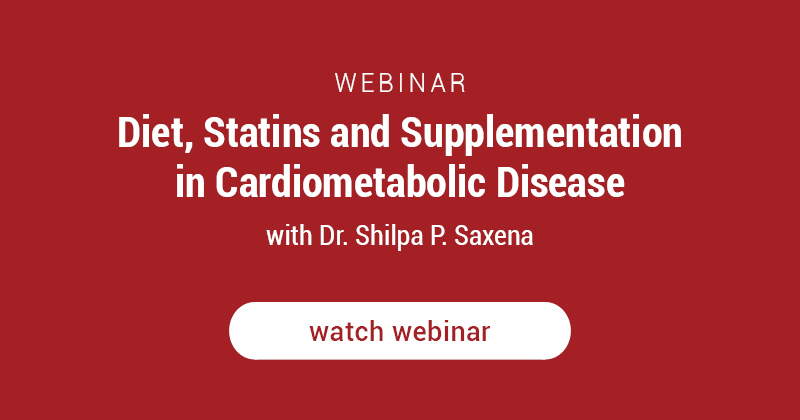While I enjoy writing technical posts, my passion lives with sharing patient stories as clinical education. In our provider world, we call these “case studies,” but to me, it’s so sterile-sounding. These are real people—parents, siblings, children—unique individuals who all have a life they literally hand to us so it can be optimized and juiced for everything it’s worth. So, without further ado, I introduce you to Ken!
Ken is your typical 50-year-old man—he enjoys a good meal out, relaxing with a few beers on the weekends, isn’t very physically active due to his stressful desk job and is carrying around an extra 20 to 30 pounds of undesired weight. At his new patient appointment with me, he recalls being diagnosed with high cholesterol “a few years back” and being prescribed statins. He tried them but felt awful; so, like many, he just stopped taking them and stopped seeing that doctor. Why should he go back? There was no other option for him as he understood it. He was genetically doomed with high cholesterol, and he would just have to accept that risk in life.
Fast forward. Because it’s what people his age talk about at gatherings on the weekends, he learns there is an “alternative” approach to high cholesterol and quickly finds our office. On his first visit, we were equally curious about his risks, so I ordered some advanced cardiometabolic labs alongside some of routine labs to understand his expanded risk profile. Here’s what we found: His LDL was super high (i.e. LDL-c- 279, LDL-P 1989) placing him at high risk for heart disease. His triglycerides were also too high (TG 207). And although his HDL was OK at 41 by the “Reference Range,” I could already see that Ken was dealing with more than just a cardiovascular issue—he was also dealing with an added set of cardiometabolic risks. Seeing this potential for blood sugar and insulin dysfunction expressing as high triglycerides and low HDL (and metabolic syndrome to be exact), I dug even deeper. Seeing that Ken’s fasting blood glucose was abnormally high at 127, it was likely his body was not properly metabolizing the quality or quantity of the calories he was consuming. We added a HgbA1c to his blood already in the lab, and we found he was actually more than just a random “high blood sugar” on a screening lab—he was an outright uncontrolled diabetic with an A1c of 8.2!
So, there he was, a newly diagnosed diabetic, overweight, sedentary, stressed out and ignoring a “high cholesterol” for years. He represents what so many Americans are dealing with today: major hidden risks and a paucity of therapeutic options. With over 67% of Americans being overweight or obese, it’s no surprise that diabetes and heart disease trends continue to climb alongside the obesity curves (even in kids!). But here’s how Ken’s story is amazingly different than what most patients experience in their health care story.
After reviewing his labs, I told him that cholesterol medication and diabetes medication would be recommended based on conventional medicine guidelines. He was shocked! He respectfully retaliated (as I would love from any patient willing to fight for his right for a “life without pharmaceuticals”). I advised him on how he could absolutely turn his condition around with a trial of lifestyle medicine, but it would take some education on my part and a lot of dedication on his part!
We provided the critical information (cardiometabolic food plan, food label education, coaching, body composition testing, exercise education, stress management, etc.). He brought the serious dedication—and I mean serious! For the first time in a long time, Ken put his health first. He was off and running, cutting back on breads, refined sugars, fast-food meals and restaurant indulgences. He began a love affair with vegetables, beans and fruit (a group of foods he never thought he could really come to like).
He began eating smaller portions, timing them every three to four hours, making sure he took in adequate amounts of lean, clean protein throughout the day. He even started exercising eventually. I mean really exercising, and he’s now up to five times per week at a minimum because he likes how it makes him feel—not “because he has to,” as he puts it.
So, here’s the drumroll moment…in just 12 short weeks...Ken’s LDL-c dropped 163 points!! His triglycerides dropped 97 points and his blood glucose results went back to an optimal fasting range. Ken was no longer diabetic by his HgbA1c! He was no longer a candidate for cholesterol medication or diabetes medication. He actually lost 50 pounds over five months through good old-fashioned healthy eating and exercise, without dangerous prescription weight loss medications. He has more energy than ever and is the best living advertisement for therapeutic lifestyle change!
Many conventional clinicians fail to give therapeutic lifestyle change a chance even though it is in the ATP3 guidelines as a primary course of action. Many functional medicine physicians want to give it a go but need some support to leverage it powerfully. Without the implementation of health coaches and/or lifestyle-based group medical appointments, it does become cost-prohibitive to patients to get this level of support.
Now, here’s the truth. Not everyone is Ken. Some people take longer to come around; some people never do, whether by choice or by circumstances. So, what happens to them? Well, it’s time to go to Plan B. As clinicians, we must navigate the risks, benefits and alternatives to pharmaceutical and nutraceutical options as we make up the difference between the patient’s actual labs and the healthy goals for each one of these risk factors or biomarkers. There isn’t a one-size-fits all approach, but there is a method that can be used to make wise decisions with your patients and honor the medicolegal standards we must also follow.
Around the office, we often laugh about those commercials for medications that say, “When diet and exercise fail…” The truth is, diet and exercise don’t fail...the system usually fails diet and exercise! Fortunately, there’s a lot we can still offer as we optimize access to lifestyle medicine for all. And sometimes, I must admit, that includes a pharmaceutical. Statins aren’t evil. They just aren’t the only option. Most patients want to know that they have done an honest job trying to avoid a pharmaceutical through any safer means. If they find that their efforts didn’t work as well as they would have liked, they are comforted by the fact they have likely reduced their risk and created a new status where they need less pharmaceuticals, specialists or procedures. That’s the end game. Leverage lifestyle medicine and use riskier options only as needed.
Join me as we explore how to comprehensively reduce cardiometabolic risks and improve the odds for a happy story for more and more patients. Learn more about the CM Vitals Program here.

Shilpa P. Saxena, MD is a Board-Certified Family Practice physician whose passion and purpose come to life through sharing her innovative patient education and practice management solutions in her classic ‘keep it simple’ style. She serves as Faculty with the Institute for Functional Medicine and the Arizona Center for Integrative Medicine. She also serves as the Clinical Expert at the Lifestyle Matrix Resource Center for the CM Vitals Program. Dr. Saxena is an expert in the Group Visit medical model, creator of Group Visit Toolkits, and co-author of The Ingredients Matter: India.




